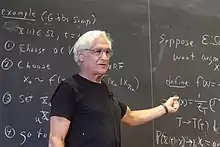Stuart Geman
Stuart Alan Geman (born March 23, 1949) is an American mathematician, known for influential contributions to computer vision, statistics, probability theory, machine learning, and the neurosciences.[1][2][3][4] He and his brother, Donald Geman, are well known for proposing the Gibbs sampler, and for the first proof of convergence of the simulated annealing algorithm.[5][6]
Stuart A. Geman | |
|---|---|
 Geman lecturing on the Gibbs sampler | |
| Born | March 23, 1949 |
| Nationality | American |
| Alma mater | University of Michigan B.S. (1971) Dartmouth College M.S. (1973) Massachusetts Institute of Technology Ph.D. (1977) |
| Relatives | Donald Geman (brother) |
| Scientific career | |
| Fields | Mathematics |
| Institutions | Brown University |
| Thesis | Stochastic Differential Equations with Smooth Mixing Processes (1977) |
| Doctoral advisor | Herman Chernoff Frank Kozin |
| Doctoral students | Barry R. Davis |
| Website | www |
Biography
Geman was born and raised in Chicago. He was educated at the University of Michigan (B.S., Physics, 1971), Dartmouth Medical College (MS, Neurophysiology, 1973), and the Massachusetts Institute of Technology (Ph.D, Applied Mathematics, 1977).
Since 1977, he has been a member of the faculty at Brown University, where he has worked in the Pattern Theory group, and is currently the James Manning Professor of Applied Mathematics. He has received many honors and awards, including selection as a Presidential Young Investigator and as an ISI Highly Cited researcher. He is an elected member of the International Statistical Institute, and a fellow of the Institute of Mathematical Statistics and of the American Mathematical Society.[7] He was elected to the US National Academy of Sciences in 2011.
Work
Geman's scientific contributions span work in probabilistic and statistical approaches to artificial intelligence, Markov random fields, Markov chain Monte Carlo (MCMC) methods, nonparametric inference, random matrices, random dynamical systems, neural networks, neurophysiology, financial markets, and natural image statistics. Particularly notable works include: the development of the Gibbs sampler, proof of convergence of simulated annealing,[8][9] foundational contributions to the Markov random field ("graphical model") approach to inference in vision and machine learning,[3][10] and work on the compositional foundations of vision and cognition.[11][12]
Notes
- Thomas P. Ryan & William H. Woodall (2005). "The Most-Cited Statistical Papers". Journal of Applied Statistics. 32 (5): 461–474. doi:10.1080/02664760500079373. S2CID 109615204.
- S. Kotz & N.L. Johnson (1997). Breakthroughs in Statistics, Volume III. New York, NY: Springer Verlag.
- [Wikipedia] List of important publications in computer science.
- Sharon Bertsch Mcgrayne (2011). The theory that would not die. New York and London: Yale University Press.
- S. Geman; D. Geman (1984). "Stochastic Relaxation, Gibbs Distributions, and the Bayesian Restoration of Images". IEEE Transactions on Pattern Analysis and Machine Intelligence. 6 (6): 721–741. doi:10.1109/TPAMI.1984.4767596. PMID 22499653. S2CID 5837272.
- Google Scholar: Stochastic Relaxation, Gibbs Distributions and the Bayesian Restoration.
- List of Fellows of the American Mathematical Society, retrieved 2013-08-27.
- P.J. van Laarhoven & E.H. Aarts (1987). Simulated annealing: Theory and applications. Netherlands: Kluwer. Bibcode:1987sata.book.....L.
- P. Salamon; P. Sibani; R. Frost (2002). Facts, Conjectures, and Improvements for Simulated Annealing. Philadelphia, PA: Society for Industrial and Applied Mathematics.
- C. Bishop (2006). Pattern recognition and machine learning. New York: Springer.
- N. Chater; J.B. Tenenbaum & A. Yuille (2005). "Probabilistic models of cognition: Conceptual foundations" (PDF). Trends in Cognitive Sciences. 10 (7): 287–291. doi:10.1016/j.tics.2006.05.007. PMID 16807064. S2CID 7547910.
- B. Ommer & J.M. Buhmann (2010). "Learning the compositional structure of visual object categories for recognition". IEEE Transactions on Pattern Analysis and Machine Intelligence. 32 (3): 501–516. CiteSeerX 10.1.1.297.2474. doi:10.1109/tpami.2009.22. PMID 20075474. S2CID 11002928.